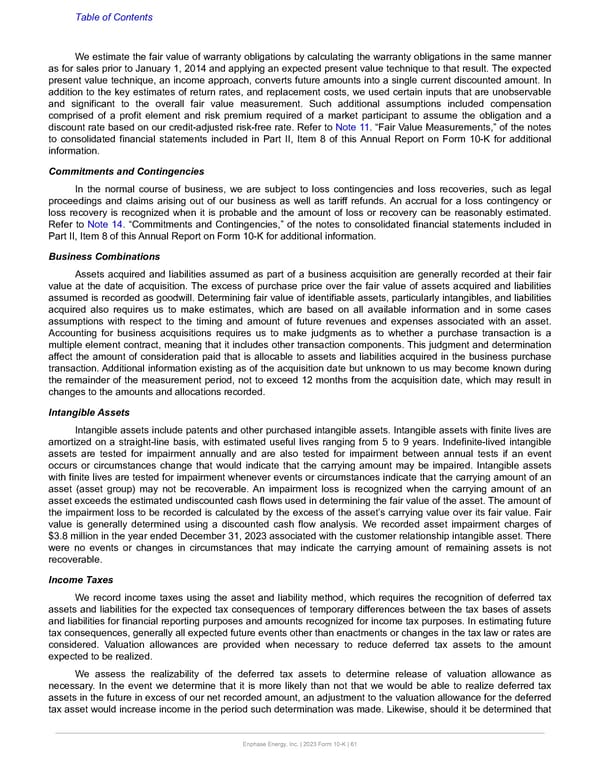Table of Contents We estimate the fair value of warranty obligations by calculating the warranty obligations in the same manner as for sales prior to January 1, 2014 and applying an expected present value technique to that result. The expected present value technique, an income approach, converts future amounts into a single current discounted amount. In addition to the key estimates of return rates, and replacement costs, we used certain inputs that are unobservable and significant to the overall fair value measurement. Such additional assumptions included compensation comprised of a profit element and risk premium required of a market participant to assume the obligation and a discount rate based on our credit-adjusted risk-free rate. Refer to Note 11. “Fair Value Measurements,” of the notes to consolidated financial statements included in Part II, Item 8 of this Annual Report on Form 10-K for additional information. Commitments and Contingencies In the normal course of business, we are subject to loss contingencies and loss recoveries, such as legal proceedings and claims arising out of our business as well as tariff refunds. An accrual for a loss contingency or loss recovery is recognized when it is probable and the amount of loss or recovery can be reasonably estimated. Refer to Note 14. “Commitments and Contingencies,” of the notes to consolidated financial statements included in Part II, Item 8 of this Annual Report on Form 10-K for additional information. Business Combinations Assets acquired and liabilities assumed as part of a business acquisition are generally recorded at their fair value at the date of acquisition. The excess of purchase price over the fair value of assets acquired and liabilities assumed is recorded as goodwill. Determining fair value of identifiable assets, particularly intangibles, and liabilities acquired also requires us to make estimates, which are based on all available information and in some cases assumptions with respect to the timing and amount of future revenues and expenses associated with an asset. Accounting for business acquisitions requires us to make judgments as to whether a purchase transaction is a multiple element contract, meaning that it includes other transaction components. This judgment and determination affect the amount of consideration paid that is allocable to assets and liabilities acquired in the business purchase transaction. Additional information existing as of the acquisition date but unknown to us may become known during the remainder of the measurement period, not to exceed 12 months from the acquisition date, which may result in changes to the amounts and allocations recorded. Intangible Assets Intangible assets include patents and other purchased intangible assets. Intangible assets with finite lives are amortized on a straight-line basis, with estimated useful lives ranging from 5 to 9 years. Indefinite-lived intangible assets are tested for impairment annually and are also tested for impairment between annual tests if an event occurs or circumstances change that would indicate that the carrying amount may be impaired. Intangible assets with finite lives are tested for impairment whenever events or circumstances indicate that the carrying amount of an asset (asset group) may not be recoverable. An impairment loss is recognized when the carrying amount of an asset exceeds the estimated undiscounted cash flows used in determining the fair value of the asset. The amount of the impairment loss to be recorded is calculated by the excess of the asset’s carrying value over its fair value. Fair value is generally determined using a discounted cash flow analysis. We recorded asset impairment charges of $3.8 million in the year ended December 31, 2023 associated with the customer relationship intangible asset. There were no events or changes in circumstances that may indicate the carrying amount of remaining assets is not recoverable. Income Taxes We record income taxes using the asset and liability method, which requires the recognition of deferred tax assets and liabilities for the expected tax consequences of temporary differences between the tax bases of assets and liabilities for financial reporting purposes and amounts recognized for income tax purposes. In estimating future tax consequences, generally all expected future events other than enactments or changes in the tax law or rates are considered. Valuation allowances are provided when necessary to reduce deferred tax assets to the amount expected to be realized. We assess the realizability of the deferred tax assets to determine release of valuation allowance as necessary. In the event we determine that it is more likely than not that we would be able to realize deferred tax assets in the future in excess of our net recorded amount, an adjustment to the valuation allowance for the deferred tax asset would increase income in the period such determination was made. Likewise, should it be determined that Enphase Energy, Inc. | 2023 Form 10-K | 61
 Annual Report Page 60 Page 62
Annual Report Page 60 Page 62